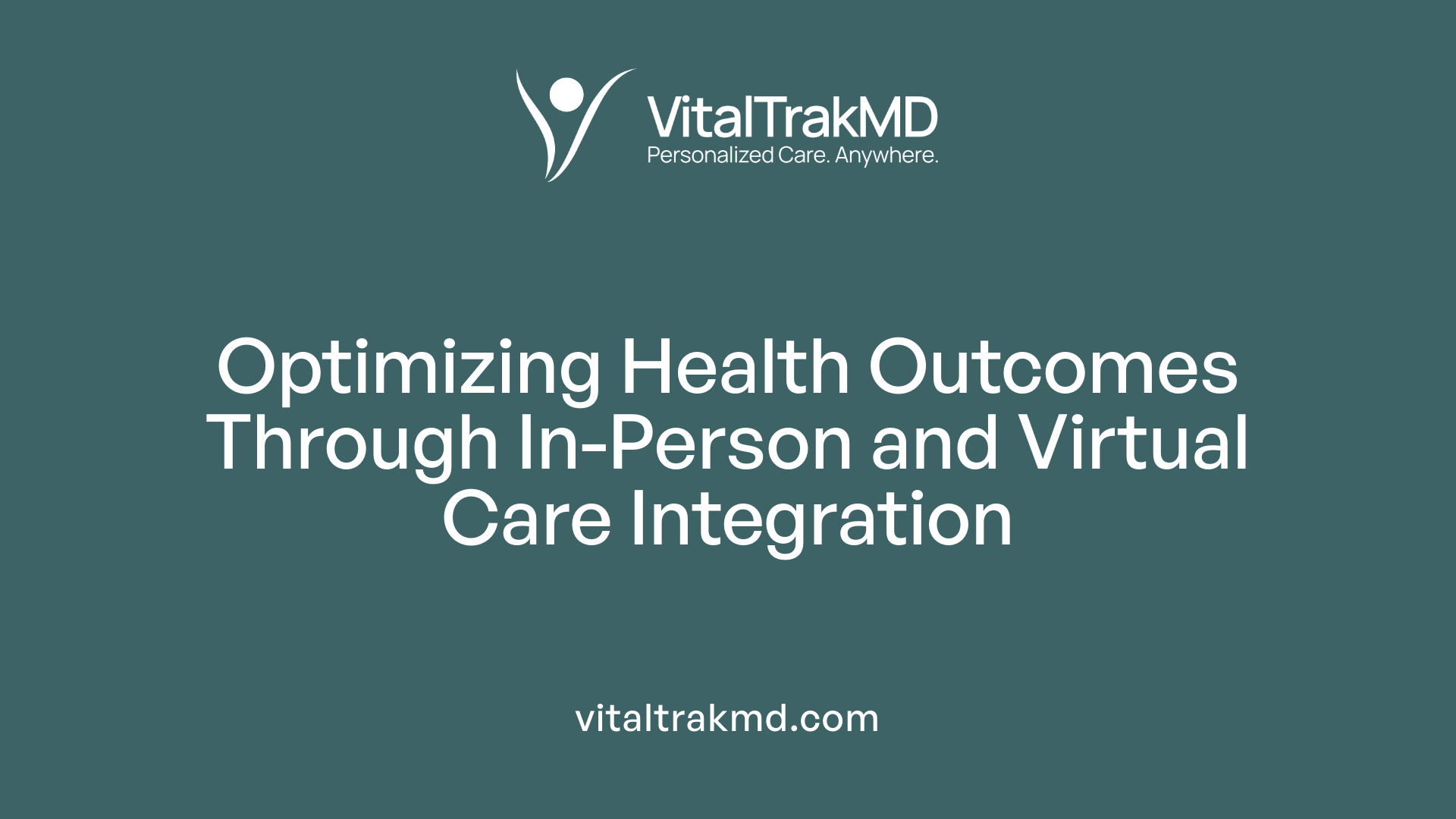Why Hybrid Care Promotes Long-Term Adherence to Health Plans

Understanding the Significance of Hybrid Care in Modern Healthcare
As healthcare evolves, hybrid care models—integrating traditional in-person visits with innovative telehealth and digital tools—are proving essential for promoting long-term adherence to health plans. These models foster continuous, personalized, and accessible care, ultimately leading to improved health outcomes and system efficiencies.
The Foundations and Components of Hybrid Care
 Hybrid healthcare integrates in-person patient visits with a variety of digital tools and telehealth services to improve care delivery. This combination allows providers to leverage the strengths of both traditional and digital approaches, creating a more flexible and accessible healthcare experience.
Hybrid healthcare integrates in-person patient visits with a variety of digital tools and telehealth services to improve care delivery. This combination allows providers to leverage the strengths of both traditional and digital approaches, creating a more flexible and accessible healthcare experience.
Core components include telehealth platforms that enable video consultations, remote therapeutic monitoring devices that track patient health data from home, and interactive patient education resources to promote self-management. Mobile apps serve as tools for appointment scheduling, medication reminders, and health tracking, empowering patients to stay engaged with their care plans.
Additional technological tools such as virtual triage help rapidly assess patient needs, guiding them to appropriate levels of care. Motion capture, augmented reality (AR), and virtual reality (VR) systems are also increasingly used to assist in physical therapy and rehabilitation by providing immersive, remote assessments.
Supporting adherence to treatment in hybrid models relies heavily on innovative tools like AI-driven systems, including machine learning and generative AI, which enhance diagnostics and personalize treatment plans. Wearable sensors and advanced monitoring devices enable continuous health surveillance, making it easier for patients to follow prescribed therapies.
Effective communication channels, including secure messaging, video conferencing, and patient portals, foster ongoing engagement between patients and care teams. Integrated electronic health records (EHRs) and scheduling systems ensure a seamless flow of information, improving coordination and follow-up.
Overall, the combination of these tools and components creates a robust infrastructure for hybrid healthcare, promoting adherence, better health outcomes, and patient satisfaction.
Enhancing Patient Motivation and Engagement
 Hybrid healthcare models significantly boost patient motivation and participation by making healthcare more convenient and adaptable to individual lifestyles. Patients can choose between virtual or in-person visits, which aligns with their personal preferences and daily schedules, reducing the hassle of travel and time constraints.
Hybrid healthcare models significantly boost patient motivation and participation by making healthcare more convenient and adaptable to individual lifestyles. Patients can choose between virtual or in-person visits, which aligns with their personal preferences and daily schedules, reducing the hassle of travel and time constraints.
Digital tools play a vital role in supporting patient engagement within these models. Telemonitoring devices provide real-time health data, keeping patients informed about their condition. Automated reminders, such as medication prompts and appointment alerts, encourage adherence to treatment plans. Two-way messaging platforms foster direct communication, allowing patients to ask questions and receive timely feedback from healthcare providers.
One of the main advantages of hybrid care is its ability to eliminate common barriers like transportation issues, long travel distances, and limited access for rural or underserved populations. This increased accessibility promotes consistent engagement, reducing no-shows and improving health outcomes.
Real-time communication channels enable continuous support, strengthening the relationship between patients and providers. This ongoing interaction motivates patients to stay involved in their care, adhere to prescribed protocols, and make informed decisions.
Personalization further enhances motivation. Customizing digital interactions based on patient age, condition, and preferences ensures relevance and fosters a sense of personal care. When patients feel their individual needs are understood and addressed, their commitment to health plans often increases, leading to better participation and healthier results.
Driving Long-Term Adherence Through Hybrid Care

How do hybrid healthcare models combine in-person and virtual care?
Hybrid healthcare merges traditional face-to-face visits with digital health services like telehealth, remote patient monitoring, and online support tools. Patients can see their healthcare providers in person for assessments or treatments while also engaging via video calls, mobile apps, and online resources for follow-up, education, and ongoing management.
This blended approach creates a flexible healthcare experience, allowing patients to choose the most suitable mode of care based on their needs, preferences, and circumstances.
How does continuous monitoring and personalized support improve adherence?
Digital tools enable real-time tracking of health data through remote monitoring devices and apps. Healthcare providers can use this information to intervene early if problems arise, adjusting treatments promptly.
Personalized support, such as tailored feedback and digital therapeutics, fosters a stronger patient-provider connection. It helps patients understand their condition better and stay motivated to adhere to their health plans.
What barriers does hybrid care help overcome?
Transportation issues, long distances, and mobility limitations can hinder consistent healthcare access. Hybrid models eliminate the need for frequent travel, making it easier for patients—especially those in remote or underserved areas—to stick to their treatment schedules.
Time constraints and work commitments also become less of an obstacle when virtual options are available. Patients can fit appointments into their routines more conveniently.
In what ways does hybrid healthcare enhance accessibility for chronic disease management?
Chronic conditions require ongoing management beyond occasional visits. Hybrid care models provide continuous access to healthcare through remote check-ins, virtual consultations, and digital tools that support medication adherence, lifestyle changes, and early detection of complications.
This approach supports sustained health behaviors, encourages patient engagement, and reduces the need for emergency visits or hospitalization.
| Aspect | Benefits | Details |
|---|---|---|
| Flexibility | Increased convenience | Patients can choose in-person or virtual options based on their preferences |
| Engagement | Better adherence | Continuous monitoring and personalized digital tools keep patients involved |
| Access | Overcomes geographical barriers | Remote monitoring and telehealth reach underserved populations |
| Outcomes | Improved health results | Timely interventions and ongoing support lead to better long-term health |
How do these models impact long-term health behavior?
By providing accessible, continuous, and personalized care, hybrid healthcare encourages patients to stay committed to health goals. Digital engagement tools, combined with the therapeutic value of in-person interactions, create a supportive environment for sustained healthy behaviors.
Overall, hybrid care models are transforming healthcare by making it more patient-centered, accessible, and effective in promoting long-term adherence and improved health outcomes.
Supporting Chronic Conditions with Hybrid Approaches

How do hybrid care systems encourage sustained patient engagement and compliance?
Hybrid healthcare models promote ongoing patient involvement by integrating traditional in-person care with digital health tools. This combination provides continuous communication channels, making it easier for patients to stay connected with their healthcare team.
Digital features such as telehealth consultations, remote therapeutic monitoring, and patient mobile apps enable individuals to access health information, receive reminders, and track their progress from the comfort of their homes. This convenience encourages patients to adhere to their treatment plans consistently.
Furthermore, hybrid care fosters a sense of partnership. Regular virtual check-ins and educational resources help patients understand their conditions and actively participate in their recovery or management strategies. This personalized and flexible approach helps build trust and motivates patients to stay engaged over the long term.
By addressing barriers like transportation issues, mobility limitations, or digital literacy challenges through tailored support and training, hybrid models ensure wider access and sustained compliance. Overall, combining in-person and digital interventions creates a more responsive, patient-centered environment that improves health outcomes and optimizes resource use.
Combining In-Person and Virtual Care for Better Outcomes

Why is combining in-person and virtual care effective for improving health outcomes over time?
Blending in-person visits with virtual health services creates a flexible, patient-centric model that leverages the advantages of both approaches. Virtual care provides easy access, especially for those in remote or underserved areas, helping to eliminate travel barriers, wait times, and promote ongoing engagement.
Remote monitoring tools, teleconsultations, and digital communication enable patients to manage their conditions more consistently, improving medication adherence and early detection of issues. These benefits support better management of chronic diseases and reduce the need for emergency interventions.
However, in-person visits are crucial for physical examinations, complex procedures, and establishing a personal connection. They ensure that healthcare providers can assess physical health comprehensively and tailor treatments accordingly.
The integration of these care modes allows healthcare systems to optimize resource use, lower costs, and reduce hospitalizations. It also promotes proactive care by enabling continuous monitoring and quick follow-up, which over time enhances overall health outcomes.
By combining technology and personal care, hybrid models foster a more adaptable, efficient healthcare environment. This approach ultimately leads to sustained improvements in patient health, satisfaction, and long-term treatment success.
How resource utilization improves with this hybrid approach
Hybrid care models better allocate healthcare resources by triaging patients effectively. Less critical cases can be managed remotely, freeing in-person slots for more urgent or complex matters.
This system reduces unnecessary hospital visits, lowers healthcare costs, and decreases provider workload. Additionally, virtual tools support early intervention, which can prevent disease progression and reduce costly interventions later.
In conclusion, integrating in-person and virtual care aligns with evolving patient expectations and healthcare demands, creating a resilient model capable of delivering high-quality, cost-effective care over time.
Impact of Hybrid Approaches on Long-Term Health Management
What is the impact of integrated hybrid approaches on long-term health management and adherence?
Integrated hybrid care models have a profound effect on managing health over the long term. By blending traditional in-person visits with telehealth and digital tools, these approaches create more flexible and accessible healthcare experiences for patients.
One of the main advantages is improved ongoing monitoring. Devices like remote therapeutic monitoring systems and patient mobile apps enable continuous tracking of health metrics. This constant oversight helps catch issues early, reducing the risk of complications and hospital readmissions.
Personalized care pathways are another benefit. Using data collected through digital tools and AI-powered chatbots, healthcare providers can tailor treatments and send timely reminders for medication or lifestyle changes. These features foster greater patient engagement and adherence to treatment plans.
Enhanced communication through virtual follow-ups and digital health platforms supports sustained patient-provider relationships. This trust not only improves adherence but also promotes a holistic approach to care, addressing physical, emotional, and social needs.
Studies indicate that hybrid models decrease healthcare costs by reducing unnecessary hospital visits and admissions. They also help streamline resource use, making long-term management more efficient.
By integrating advanced technologies like AI, remote monitoring, and continuous feedback, hybrid healthcare creates a resilient system. It effectively combines the strengths of traditional and digital care, leading to better health outcomes and stronger, more engaged patient communities.
Overcoming Challenges in Hybrid Care Implementation
The Economic and Policy Landscape of Hybrid Healthcare
Why is combining in-person and virtual care effective for improving health outcomes over time?
Combining in-person and virtual care creates a hybrid, patient-centered approach that maximizes the strengths of both modalities. This blend enhances access and engagement for diverse populations, ensuring that patients receive timely and appropriate care.
Virtual care offers unmatched convenience by reducing travel, wait times, and logistical barriers. It facilitates remote monitoring and management of chronic conditions, which can lead to better patient adherence and improved clinical outcomes.
At the same time, in-person visits are still vital for physical examinations, complex procedures, and establishing a personal connection between healthcare providers and patients. This face-to-face interaction supports comprehensive assessments and tailored treatment plans.
Integrating these two approaches allows healthcare systems to optimize resource use, cut costs, and reduce hospitalizations or emergency visits. This proactive, continuous care model adapts to patient needs more effectively, leading to better health outcomes over time.
Regulatory shifts and reimbursement changes driving hybrid care adoption
Recent policy changes are significantly accelerating the shift toward hybrid healthcare. Governments and health authorities are increasingly endorsing telehealth through reimbursement policies for remote monitoring and virtual visits.
In many countries, reforms include extending telemedicine coverage, allowing reimbursement parity with in-person visits, and loosening regulations that previously limited digital health deployment.
Resource allocation is also evolving to support technology infrastructure, training, and security measures necessary for safe and effective hybrid care.
Cost savings and shifting healthcare spending
Hybrid healthcare models present substantial financial benefits. Patients save on transportation and time costs, while providers reduce overhead expenses associated with in-person services.
This approach also lowers hospital costs by enabling programs like hospital-at-home, which provide effective care in a lower-cost setting.
The shift towards outpatient, rehabilitative, and long-term care sectors aligns with structural changes to healthcare spending, emphasizing efficiency and sustainability.
Policy reforms supporting hybrid adoption
Effective policies are critical for mainstreaming hybrid healthcare. They should focus on standardizing telehealth practices, establishing reimbursement frameworks, and maintaining regulatory flexibility.
Harmonized definitions and consistent reimbursement policies across regions can reduce confusion and facilitate wider adoption.
Supporting infrastructure development, including interoperable systems and secure platforms, is also essential.
Engaging stakeholders—patients, providers, payers, and regulators—in policy design ensures that hybrid models meet real-world needs and promote equitable access.
| Aspect | Description | Impact |
|---|---|---|
| Regulatory Environment | Telehealth reimbursement policies, safety standards, licensure | Facilitates broader adoption, ensures patient safety |
| Resource Allocation | Infrastructure investments, training, cybersecurity | Supports effective implementation |
| Cost Dynamics | Savings for patients, reduced hospital and provider costs | Encourages sustained use |
| Policy Focus | Standardization, reimbursement parity, flexible regulations | Promotes growth and innovation |
As healthcare continues to evolve, embracing innovative policy frameworks and aligning incentives will be crucial for unlocking the full potential of hybrid care systems.
The Future of Healthcare: A Hybrid Model
What is the impact of integrated hybrid approaches on long-term health management and adherence?
Integrated hybrid healthcare models are transforming the way chronic conditions are managed over time. By blending in-person visits with digital health tools like telemonitoring, remote consultations, and AI-driven support systems, these models offer increased flexibility and accessibility for patients.
Patients benefit from continuous monitoring outside the clinic, which helps in early detection of potential issues and timely intervention. This ongoing engagement encourages better adherence to treatment plans, such as medication routines, lifestyle changes, and follow-up appointments.
Advanced remote technologies, including AI-powered chatbots and digital health platforms, send reminders, provide education, and offer remote support. These features help patients stay committed to their health goals, reducing missed appointments and hospitalizations.
Moreover, hybrid approaches foster stronger relationships between patients and healthcare providers. Through combined digital and in-person contact, providers can deliver personalized, holistic care tailored to individual needs.
Reducing hospital readmissions and complications leads to lower healthcare costs and less system strain. Overall, integrated hybrid models create a more resilient, efficient, and patient-centered health management system, paving the way for sustainable long-term health outcomes.
Technological advancements, policy reforms, and patient expectations
Technological progress such as generative AI, remote sensors, and augmented reality plays a significant role in enabling seamless hybrid care. These innovations facilitate automated consultations, advanced home monitoring, and enriched virtual interactions.
Policy reforms are also vital. Countries are adopting new reimbursement models and regulatory policies to support telehealth and remote monitoring, making hybrid care more sustainable and accessible.
Patients now expect healthcare that is convenient, personalized, and continuously available. Their increased familiarity with digital tools, driven by high internet and smartphone usage, makes hybrid healthcare a practical and appealing approach.
By aligning technological developments with evolving policies and patient preferences, healthcare providers can deliver more effective care that meets modern expectations.
| Aspect | Impact | Examples/Notes |
|---|---|---|
| Technology advancements | Enable remote diagnostics, monitoring | AI, wearables, virtual reality, smart sensors |
| Policy reforms | Support reimbursement, regulation | Telemedicine reimbursement, telehealth in pharmacies, safety standards |
| Patient expectations | Demand for accessible, personalized care | Increased internet and smartphone use, preference for hybrid models |
This synergy drives the future of healthcare towards more accessible, efficient, and patient-focused services, promising improved health outcomes and system sustainability.
Harnessing the Potential of Hybrid Healthcare for a Better Future
As healthcare continues to embrace digital transformation, hybrid care models stand out as a vital approach for ensuring long-term patient adherence and improved health outcomes. By leveraging an array of advanced technological tools, fostering stronger patient-provider relationships, and overcoming traditional barriers to access, hybrid healthcare offers a sustainable path forward. When effectively implemented, these models support proactive, personalized, and equitable care—a necessity for managing chronic conditions and promoting overall well-being in our evolving healthcare landscape. Ultimately, the integration of in-person and virtual care is poised to redefine healthcare delivery, ensuring resilient and patient-centered systems capable of meeting future health needs.
References
- What Is Hybrid Healthcare? | Tools, Benefits, and Solutions
- Going Beyond Digital: Why Hybrid Care is the Future of ...
- The Future of Health Care Is Hybrid
- How Telemedicine Is Improving Patient Outcomes and ...
- How a hybrid approach to telehealth improves patient care ...
- Integrating Telehealth and Traditional Care in Chronic Pain ...
- Hybrid Care Is a Game Changer for MSK Treatment
- How Telemedicine Is Improving Patient Outcomes and ...
- What Is Hybrid Healthcare? | Tools, Benefits, and Solutions
- the transformative role of AI-powered hybrid chatbots in ...
Recent articles
Want to Feel Better and Live Healthier?
Join hundreds of patients taking control of their health with personalized care that fits their life – not the other way around.
Rated 4.8/5 by 32+ customers







